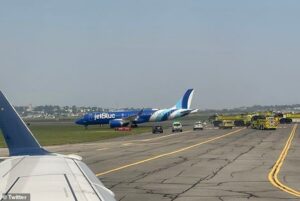On June 12, 2025, the world was still reeling from the catastrophic crash of Air India Flight AI171 in Ahmedabad, India, which claimed 265 lives in a fiery plunge into a medical hostel. Just one day later, on June 12, 2025, another aviation incident sent shockwaves through the industry: JetBlue Flight 312, an Airbus A220-300, skidded off the runway during landing at Boston Logan International Airport, rolling into the grass. While no injuries were reported, the timing of the JetBlue incident, coming on the heels of India’s tragedy, has heightened global concerns about aviation safety. From the miraculous survival of Vishwash Kumar Ramesh to the narrow escape of Bhoomi Chauhan, these events weave a tapestry of loss, survival, and unsettling questions about the skies we trust.
The Air India Tragedy
Air India Flight AI171, a Boeing 787-8 Dreamliner, took off from Ahmedabad’s Sardar Vallabhbhai Patel International Airport at 1:38 p.m. on June 12, bound for London’s Gatwick Airport. Carrying 242 passengers and crew, including 169 Indian nationals and 53 British citizens, the flight was a mosaic of dreams—families like Pratik Joshi’s, who had secured visas after six years, and brothers Vishwash and Ajay Ramesh, returning to Leicester. Thirty-two seconds after takeoff, at 625 feet, a loud bang signaled disaster. A “Mayday” call reported “no thrust,” and the plane, unable to climb, crashed into the BJ Medical College hostel, killing 241 aboard and 24 on the ground.
Preliminary investigations point to a bird strike as a potential cause, with Ahmedabad’s high bird activity—38 strikes in 2022–23—supporting the theory. A flock may have crippled both GE Aerospace GEnx-1B engines, causing a rare double failure. The Flight Data Recorder, recovered by India’s Aircraft Accident Investigation Bureau (AAIB), is under analysis, while the Cockpit Voice Recorder remains missing. The crash, the first fatal incident for the Boeing 787, has sparked calls for better wildlife management and stricter zoning, as the hostel’s proximity to the runway amplified the tragedy.
Vishwash Kumar Ramesh, seated in 11A near an emergency exit, was the sole survivor, escaping with bruises but losing his brother Ajay, in 11J. “I woke up surrounded by bodies,” Vishwash said, his pleas for Ajay haunting millions. Bhoomi Chauhan, a Bharuch native, missed the flight by 10 minutes due to a traffic jam, crediting Lord Ganesha for her life. The Joshi family’s viral selfie, capturing their joy before the crash, now symbolizes unbearable loss, their dreams of London extinguished.
The JetBlue Runway Scare
Less than 24 hours later, across the globe, JetBlue Flight 312, an Airbus A220-300 registered as N3242J, faced its own crisis. The flight, departing Chicago’s O’Hare International Airport at 8:41 a.m. on June 12, landed at Boston Logan International Airport at 11:49 a.m. EST. As it turned off runway 33L onto taxiway “Golf,” the plane veered left, skidding off the pavement and coming to rest on the grass. The aircraft, a five-month-old airframe delivered to JetBlue in January 2025, carried 150 passengers and crew, all of whom safely deplaned via stairs and were bussed to the terminal.

The Federal Aviation Administration (FAA) issued a ground stop, halting operations on runway 33L for about 90 minutes until 1:18 p.m. No injuries were reported, and the plane sustained no visible damage, though it remains grounded for inspection. Air traffic communications revealed the pilot lost steering control, with one pilot reporting, “We couldn’t steer.” Aviation experts suggest the brakes may have locked, or a hydraulic issue—similar to a March 2025 JetBlue A220 diversion in Boston—could have contributed. Weather, clear at the time, is unlikely to have played a role, though the investigation continues.
JetBlue, prioritizing safety, is conducting a full probe alongside the FAA and National Transportation Safety Board (NTSB). The incident, classified as a runway excursion, disrupted Logan’s operations briefly but spared the chaos of the Air India crash. Passengers, shaken but unharmed, praised the pilot’s calm handling, though the event has fueled public anxiety, amplified by its timing.
A World on Edge
The juxtaposition of these incidents—Air India’s deadly crash and JetBlue’s near-miss—has ignited global unease. The Air India tragedy left Ahmedabad grappling with grief. Prime Minister Narendra Modi visited the crash site, meeting Vishwash and consoling families, while Home Minister Amit Shah oversaw rescue efforts. Air India offered ₹1 crore (about $116,000) per victim’s family and set up support centers. Internationally, leaders like U.S. President Donald Trump and British Prime Minister Keir Starmer expressed solidarity, with the NTSB aiding India’s probe.
In Boston, the JetBlue incident, while non-fatal, underscored aviation’s fragility. Logan Airport, a hub handling 36 million passengers annually, has seen runway incidents before, including a February 2023 close call between a JetBlue flight and a Learjet. The FAA reported 30 runway incursions per million operations in 2024, down from 33 in 2023, but the JetBlue excursion highlights ongoing risks. Social media posts reflected public alarm, with users noting the eerie timing: “First Ahmedabad, now Boston—what’s happening to our skies?”
Human Stories Amid the Chaos
The Air India crash’s human toll remains raw. Vishwash Ramesh, recovering in Ahmedabad Civil Hospital, embodies both miracle and tragedy. His escape from seat 11A, near the wing’s structural spar, defied odds, but the loss of Ajay in 11J haunts him. “I don’t know why I’m alive,” he said, his voice breaking. The Joshi family’s story—Pratik, Komi, and their three children—resonates through their selfie, a fleeting moment of joy before disaster. In Banswara, their relatives mourn, their home a shrine to unfulfilled dreams.
Bhoomi Chauhan’s escape, saved by a traffic jam, offers a glimmer of hope. Back in Bharuch, she clings to her daughter, her Ganesh idol a symbol of gratitude. “I was meant to be on that plane,” she said, her relief tempered by survivor’s guilt. These stories, woven into the crash’s narrative, highlight the human cost and the randomness of fate.
The JetBlue incident, while less severe, carried its own human dimension. Passengers, disembarking onto the grass, described a surreal scene—relief mixed with fear as they realized how close they came to disaster. A mother traveling with her toddler recounted holding her child tightly as the plane slid, later praising the crew’s composure. The pilot, unnamed but lauded, maintained control, averting a worse outcome.

Investigating the Causes
The Air India investigation centers on the bird strike theory, supported by Ahmedabad’s history of 462 bird strikes over five years. A flock likely entered both engines, causing a double failure—a rare event that overwhelmed the pilots. The AAIB, with Boeing and GE Aerospace, is analyzing the black box, seeking to confirm the cause and prevent future tragedies. The crash has prompted calls for advanced bird detection systems and urban planning reforms, as the hostel’s location amplified the loss.
In Boston, the JetBlue probe focuses on mechanical and human factors. The Airbus A220’s youth—five months old—suggests no structural issues, but a steering or hydraulic failure is under scrutiny. The FAA’s investigation will examine maintenance records and pilot actions, with parallels to a March 2025 A220 diversion for hydraulic issues. Runway excursions, while common, rarely cause fatalities, but the incident’s timing has amplified its impact.
A Call for Safety
Both incidents underscore aviation’s challenges in a rapidly growing industry. India, with its booming air traffic, faces unique risks, from bird strikes to urban encroachment. The U.S., despite a strong safety record, grapples with runway incursions, with 2024 seeing a slight decline but persistent concerns. The Air India crash, killing 265, and JetBlue’s scare, sparing 150, highlight the stakes—lives hang on split-second decisions and unseen hazards.
Social media reflects global unease, with users linking the incidents to broader safety fears. Posts mourn the Joshi family and celebrate Chauhan’s escape, while questioning why birds or brakes can disrupt modern aviation. The contrast between Vishwash’s survival and Ajay’s loss in seats 11A and 11J remains a poignant thread, symbolizing life’s fragility.
A Path Forward
Ahmedabad and Boston, worlds apart, share a moment of reckoning. In India, families gather at hospitals, seeking closure through DNA tests, while Vishwash prepares to return to Leicester, forever changed. In Boston, passengers resume their journeys, grateful for a second chance. As investigations unfold, the world demands answers—whether from birds in Ahmedabad’s skies or brakes on Boston’s runways—to ensure safer flights.
The stories of Vishwash, Chauhan, and the Joshis, alongside JetBlue’s shaken passengers, remind us of aviation’s human core. From tragedy to near-miss, these events call for vigilance, innovation, and a renewed commitment to safety, so the skies remain a place of dreams, not dread.


